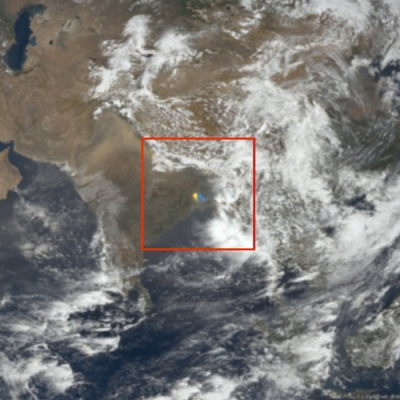Aber die Lüfte . . . aber die Räume . . . - Rilke
The intraseasonal oscillation (I/O)—a disturbance in surface pressure, tropospheric temperature, and winds—blows eastward along the equator, circling the globe within 30 to 60 days of origination. Since the phenomenon was first recognized in satellite outgoing longwave radiation (OLR) data, climate modelers have devoted considerable attention to this sporadic event, but a complete theoretical explanation of the intraseasonal oscillation's existence and erratic behavior continues to elude.
"Models based on current theories have had improving success in capturing essential features of the intraseasonal oscillation," says doctoral candidate Capt. Michael Johnson, of the Air Force Institute of Technology, currently on assignment to the Department of Meteorology at the University of Utah. "But these models typically predict I/O propagation nearly twice as fast as observed I/O events, and fail to capture the structure of individual events. This suggests that some of the essential physics involved in the creation and maintenance of the I/O are not described by present theories."
The intraseasonal oscillation represents a complex interlace of physical and radiative dynamics. The events occur five to eight times each year, propagating with varying degrees of energy. Of these occurrences, perhaps one will travel completely around the Earth. In 1987, when convective activity associated with the El Niño was at a high, one intraseasonal oscillation moved twice around the globe in about 120 days before spending itself. By unraveling the convective and radiative mysteries that combine to form an intraseasonal oscillation, researchers hope to discover the threads that connect tropical climate to weather conditions in other areas of the globe.
"A relationship between the dynamics in the tropics and what happens in the midlatitudes is a direct possibility," says Johnson. "The oscillation typically dries out as it crosses the date line, and sometimes there are teleconnections that suggest that I/O events can propagate into the higher latitudes. For instance, studies indicate that the flooding in the Mississippi Basin in summertime, 1993, may have been influenced by tropical long wave patterns, like the I/O."
Johnson is exploring the role that radiative cooling in the eastern Pacific has on the intraseasonal oscillation, in order to get a broad view of radiative transfer, dynamics, and the relationship between the two. "Very little has been done in this area on a large scale, mostly for lack of data that can be used to adequately model the radiative aspects of large-scale phenomena," he says.
Johnson developed a three-dimensional distribution of radiative flux and heating rates from 1985 through June 1991 by combining the component parts (or normal-mode decomposition) of wind and height fields from National Center for Environmental Prediction/National Center for Atmospheric Research (NCEP/NCAR) reanalysis data with information derived from Stage C-1 International Satellite Cloud Climatology Project (ISCCP) cloud data from NASA's Atmospheric Science Data Center (ASDC).
"The critical component by far is the ISCCP database," Johnson says. "It is global three-hourly data, that takes all the geostationary meteorological satellites and at least two polar orbiting meteorological satellites and mosaics their radiances. Above all, it uniquely gives optical depth properties, from which we can calculate the liquid water content of the clouds. I am parameterizing liquid and ice water content in clouds because these are the features in the atmosphere which most critically affect radiation.
"When the intraseasonal oscillation is in the Pacific Ocean, an east-west circulation pattern called a Walker cell sets up, with warm air rising over the western Pacific and cool air sinking over the eastern Pacific. We're finding there's a strong correlation between the intraseasonal oscillation and the role of radiative cooling in these sinking cells."
To verify his radiative calculations Johnson used Earth Radiation Budget Experiment (ERBE) ground truth data from ASDC. ERBE data offers the best global coverage of OLR, Johnson says, and it was for comparison reasons that the period of study was defined around the period of ERBE data availability.
Johnson calls his work "another stepping stone in describing what's happening in the tropical atmosphere." But in the process of unraveling global weather connections, he says, researchers are weaving new connections among themselves.
"Typically in the past, radiative transfer people have just done radiative transfer, looking at the radiative aspects of small detailed areas. There's a push right now for oceanographers, meteorologists and radiative transfer people to try to work together to make new discoveries on how all of these systems interact.
"Since these are such long-term events, whose essential features are so well simulated by linear models, the hope is, in the future, to be able to forecast long in advance the impacts that may be felt in other regions. But that's a long way out," he says. "First, we have to gain a better understanding of the dynamics of all these different systems."
References
Johnson, M. W., and J. Nogues-Paegle. 1996. Description of the tropical intraseasonal oscillation based on NMC Re-Analysis. Presented at the spring meeting of the American Meteorological Society, Atlanta.
For more information
NASA Atmospheric Science Data Center (ASDC)
International Satellite Cloud Climatology Project (ISCCP)
| About the remote sensing data used | ||
|---|---|---|
| Data | International Satellite Cloud Climatology Project (ISCCP) | |
| Parameter | intraseasonal oscillation | |
| DAAC | NASA Atmospheric Science Data Center (ASDC) | |
